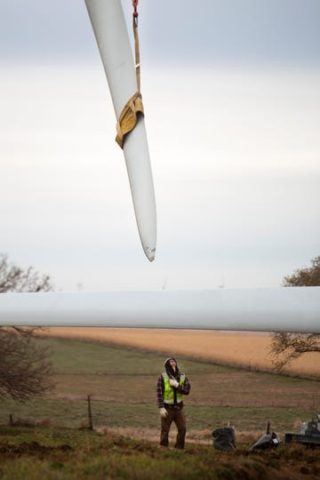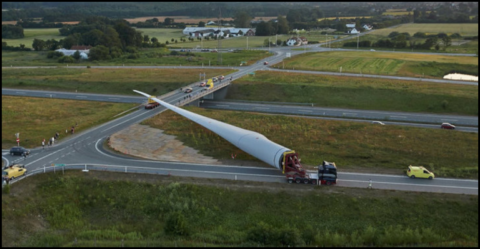Podcast: Play in new window | Download
Subscribe: RSS

Mr. Damocles, please go to the nearest courtesy phone. We found your sword. (Des Moines Register photo)
The reason that industrialism kills whatever industrialism touches is that it has only one answer to every question, one solution for every problem: scale it up! Get big or get out! But as I and many others have been pointing out for years, the economies of scale sought by industries are always accompanied by a dark twin: concentration of risk. The bigger the manufacturing plant, the lower its unit costs of production, but also the greater the pollution emitted, the denser the traffic generated in a small area, etcetera. The other thing to remember about these penalties of industrialism if that many of them are deferred. By the time the full effect of the pollution is felt, the owners of the factory have grown rich, sold out and retired.
This is what is now happening to the wind-generation industry. The first of the giant wind turbines erected are reaching the end of their service life — much sooner than anticipated — and it turns out, nobody worked up a plan for that. The school-bus sized nacelles and generators can be refurbished or their steel recycled, but the vanes are another matter. They are too big to die.
The blades have been increasing in size since the first of them went up circa 1985, but to pick a median size, a 200-foot blade contains nearly 19 tons of epoxy, fiberglass, PVC foam, wood fiber and other stuff. That’s almost 60 tons of stuff (per turbine) that can’t be crushed or recycled or composted. So what do you do with it? Take it to your friendly neighborhood landfill.
If this strikes you as a small problem, let it strike you again. First of all, the blades were expected to outlast the turbines, which were expected to last at least 20 years. But the units are barely making 15 years, the blades failing because of manufacturing defects (mostly), lightning strikes, and unusual local wind conditions. So they have to come down.

Remember the old joke about the guy who built a boat in his basement then couldn’t get it out? So these guys built a really big wind-turbine blade and now….
One of the first reports of the beginning of the onslaught was just last September, when local newspapers in Wyoming began to marvel at the shipment of over 900 decommissioned blades to the Casper Regional Landfill — the only one in the state large enough to bury the first wave — from just three windfarms (don’t you love how they call these monstrosities farms? So cute). These are circa 1985 blades, which were about 130 feet long. By 2000, the blades being installed were 330 feet long. NPR researchers estimate that during the next 20 years 720,000 tons of those vanes will pile up in the country’s landfills. After that will come the monsters being installed now, nearly 600 feet in length. (Don’t forget: get big or get out!)
Industrial wind power is in trouble not only here but all over the world, not only for this set of reasons but for many more. Germany, perhaps more than any other country, made a powerful commitment to wind power as part of its Energiewende, or energy transition, designed to reduce carbon emissions by converting to renewable sources of electricity. Since 2009 the government spent over a hundred billion euros promoting and subsidizing wind and solar generation — at industrial scales, of course. As a result, electricity is more expensive and less reliable than it was before 2009, and carbon emissions have increased every single year. Yet the government, the industry, and its handmaidens continue to proclaim it as a great success.
Industrialism kills what industrialism touches, and now it is doing its best to kill the wind. One can’t help wonder what’s next?
Hi Tom,
here are the latest numbers of newly installed onshore windturbines in Germany:
https://www.tagesschau.de/multimedia/bilder/windkraftanlagen-105~_v-videowebl.jpg
325 have been installed in 2019 (compared to 1792 in 2017), but 82 have been deinstalled in the same year, leaving us with an increase of just 243. For a variety of reasons, Germany´s wind industry is already in BIG trouble. Here are just some of the reasons:
– turbines are facing a lot of resistance from the locals whereever they are planned to be built (noone wants those ugly and noisy leviathans at their doorstep)
– suitable sites are ever harder too find for geographical reasons, too
– subsidies are not flowing as freely as they used to
– word is spreading amongst ordinary people that these things are nowhere near adequate to power the lifestyles they are used to and it´s dawning on them that huge amounts of their money has been spent on a pipe dream
greetings
Frank
Many thanks for the confirmation and the details. This is not the stuff we are seeing in our industrial news media.
One of those shorter blades is standing outside of a building at the state fairgrounds here in Minnesota. I think it’s beautiful, and would love to have ONE (not three on a pole) in my own yard.
From what you write, perhaps I can.
I wonder if an airplane has ever hit one of those monsters on a wind “farm”. The red light at the top of the pole doesn’t indicate the 300 (600?!) extra feet swiping by above it. There’s a reason we put cages on our summer fans.
Speaking of lights, I hate them. I hate LEDs, in particular- especially when they are driving towards me. I hate outdoor lights. I hate that everything in the world comes with a stupid light, making my night trips to the kitchen seem like I’ve gotten tangled in a Christmas tree. I hate that we think we need wind “farms” to make sure those horrid lights keep burning.
I want my stars back!
Sorry about the rant.
Coming soon! From a wind farm near you! It’s Adopt-a-Blade™. You, too, can own your very own disused blade from an actual wind turbine. Add to your collection of front-yard (and back-yard) hulks rusting away in the sun. Old pickup trucks, refrigerators, propane tanks, and steel ladders will appreciate the silent company from their new “big brother.” Adopt five to be planted upright and configured to give the middle finger to the gods of industry. Sizes may vary. Not responsible for shipping and receiving. No liability assumed for subsequent damage to property or sanity.
“Adopt-a-Blade™.”
Too funny.